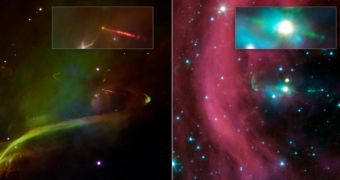Investigations of the Herbig-Haro 34 jet system have revealed the existence of a time lag between two jets shooting out of the same star. The phenomenon takes place even if the two jet are symmetrical.
Experts say that the time delay spans about 4 and a half years. The two jets are both made up of gas and dust knots, and they are blasting out of a very young star, that has yet to become truly stable.
According to the study, the star that made the object of these investigations looks very similar to how the Sun did when it was still very young. It is still unclear why most young stars produce these emission jets before they grow older.
Using the NASA Spitzer Infrared Telescope, experts are hopeful that they will be able to make sense of this. Understanding the formation of new star is a critical step towards understanding how the Universe formed and evolved into its current configuration.
“More studies are needed to determine if other jets have time delays,” explains California Institute of Technology (Caltech) NASA Spitzer Science Center (SSC) expert Alberto Noriega-Crespo.
He is a coauthor of the latest research. Details of the work were published in the April 1 issue of the esteemed Astrophysical Journal Letters, say experts with the NASA Jet Propulsion Laboratory (JPL).
“Now we know that in at least one case, there appears to be a delay, which tells us that some sort of communication may be going on between the jets that takes time to occur,” Noriega-Crespo explains.
One of the reasons why young stars produce these jets, astronomers suspect, is that it helps them reduce their rate of spin. The original spin is “imprinted” as the young star is formed through the collapse of a massive cloud of molecular hydrogen gas.
As this process takes place, a disk of matter is produced around the newborn stellar object. The disk is similar to the accretion disk around a black hole, and, like the dark behemoths themselves, they produce jets of radiation from their north and south poles.
The readings experts collected about the time delays narrow down the possible areas where these may have originated to a region spanning no more than 3 astronomical units (AU) from the new star.
An AU is the mean distance between Earth and the Sun, roughly 93 million miles. The new estimate is 10 times smaller than what experts had originally predicted based on existing evidence.
“Where we stand today on Earth was perhaps once a very violent place where high-velocity gas and dust were ejected from the disk circling around our very young Sun,” explains Alex Raga.
“If so, the formation of planets like Earth depends on how and when this phenomenon ended. Essentially, every star like our own sun has gone through a similar cloud-disk-jets formation process,” he goes on to say.
Raga is the first author of the new paper, and also a research scientist with the Universidad Nacional Autónoma de México.

 14 DAY TRIAL //
14 DAY TRIAL //